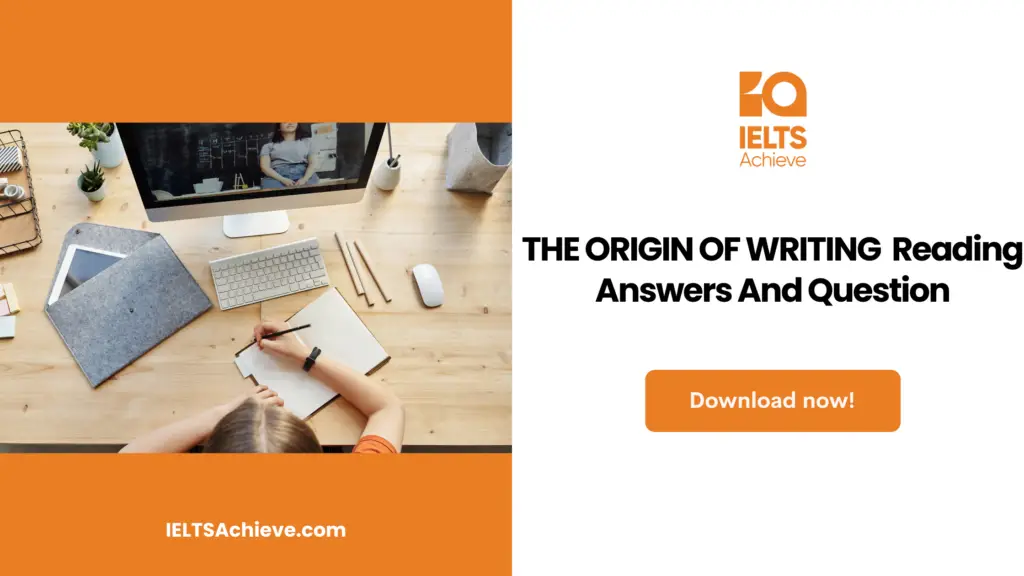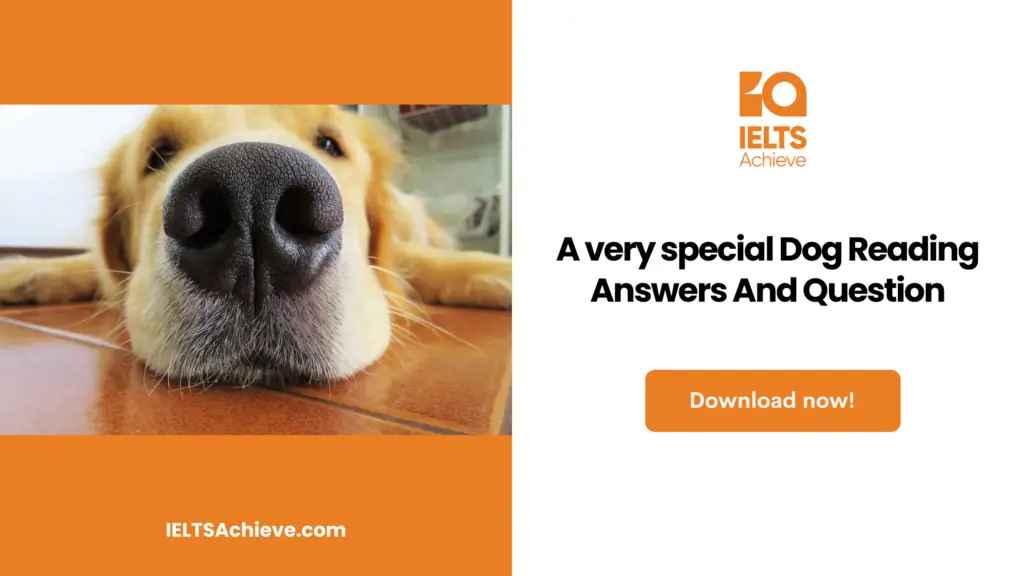The Blog post contains the following IELTS Reading Questions:
- IELTS Reading Summary Completion
- IELTS Reading True /False/not given
- IELTS Reading Matching Sentence Endings
Stay informed and prepared for success – Explore our comprehensive Reading Test Info page to get valuable insights, exam format details, and expert tips for mastering the IELTS Reading section.
IELTS Reading Passage: THE ORIGIN OF WRITING

THE ORIGIN OF WRITING
Writing was first invented by the Sumerians in ancient Mesopotamia before 3,000 BC. It was also independently invented in Meso-America before 600 BC and probably independently invented in China before 1,300 BC. It may have been independently invented in Egypt around 3,000 BC although given the geographical proximity between Egypt and Mesopotamia the Egyptians may have learnt writing from the Sumerians.
There are three basic types of writing systems. The written signs used by the writing system could represent either a whole word, a syllable or an individual sound. Where the written sign represents a word the system is known as logographic as it uses logograms which are written signs that represent a word. The earliest writing systems such as the Sumerian cuneiform, Egyptian hieroglyphics and Mayan glyphs are predominantly logographics as are modem Chinese and Japanese writing systems. Where the written sign represents a syllable the writing system is known as syllabic. Syllabic writing systems were more common in the ancient world than they are today. The Linear A and B writing systems of Minoan Crete and Mycenaean Greece are syllabic. The most common writing systems today are alphabetical. These involve the written sign (a letter) representing a single sound (known as a phoneme). The earliest known alphabetical systems were developed by speakers of semetic languages around 1700 BC in the area of modem day Israel and Palestine. All written languages will predominately use one or other of the above systems. They may however partly use the other systems. No written language is purely alphabetic, syllabic or logographic but may use elements from any or all systems.
Such fully developed writing only emerged after development from simplier systems. Talley sticks with notches on them to represent a number of sheep or to record a debt have been used in the past. Knotted strings have been used as a form of record keeping particularly in the area around the Pacific rim. They reached their greatest development with the Inca quipus where they were used to record payment of tribute and to record commercial transactions. A specially trained group of quipu makers and readers managed the whole system. The use of pictures for the purpose of communication was used by native Americans and by the Ashanti and Ewe people in Africa. Pictures can show qualities and characteristics which can not be shown by tally sticks and knot records. They do not however amount to writing as they do not bear a conventional relationship to language.
An alternative idea was that a system by which tokens, which represented objects like sheep, were placed in containers and the containers were marked on the outside indicating the number and type of tokens within the container gave rise to writing in Mesopotamia. The marks on the outside of the container were a direct symbolic representation of the tokens inside the container and an indirect symbolic representation of the object the token represented. The marks on the outside of the containers were graphically identical to some of the earliest pictograms used in Sumerian cuneiform, the worlds first written language. However cuneiform has approximately 1,500 signs and the marks on the ouside of the containers can only explain the origins of a few of those signs.
The first written language was the Sumerian cuneiform. Writing mainly consisted of records of numbers of sheep, goats and cattle and quantites of grain. Eventually clay tablets were used as a writing surface and were marked with a reed stylus to produce the writing. Thousands of such clay tablets have been found in the Sumerian city of Uruk. The earliest Sumerian writing consists of pictures of the objects mentioned such as sheep or cattle. Eventually the pictures became more abstract and were to consist of straight lines that looked like wedges.
The earliest cuneiform was an accounting system consisting of pictograms representing commodities such as sheep and a number. The clay tablets found might for example simply state “ten sheep”. Such writing obviously has its limitations and would not be regarded as a complete writing system. A complete writing system only developed with the process of phonctization. This occurs when the symbol ceases to represent an object and begins to represent a spoken sound, which in early cuneiform would be a word. This process was assisted when the symbols which initally looked very like the object they represented gradually became more abstract and less clearly related to an object. However while the symbol became more closely connected to words, it was words dealing with objects, such as sheep, bird or pot. It was still not possible to write more abstract ideas such as father, running, speech or foreigner.
The solution to this problem was known as the rebus principle. Words with the same or similar pronuciation to an abstract word could be used to represent the abstract word. The sign for eye could be used to represent the word “I”. The sign for deer could represent the word “dear”. Which word is referred to by the picture is decided by an additional sign. Pictographs which originally represented a word began to represent the sound of the word. The rebus principle is used to represent abstract words in all word writing systems in Sumer, Egypt, China and in the Aztec and Mayan writing in central America.
The Rebus principle lead to cuneiform becoming a form of logo-syllabic writing consisting of both logograms and syllabic writing. The effect of the change from logographic to logo-syllabic writing was substantial. Logographic writing cannot produce normal prose and is resticted to nouns, numbers, names and adjectives. The vast majority of early Sumerian writing consisted of bureaucratic records of products received or products distributed. Only when syllabic writing was introduced into cuneiform did it become possible to write prose such as myths and royal propaganda.
The next major development in writing in the old world was the development of the alphabet. The alphabet was developed out of Egyptian hieroglyphs which contained 24 signs for 24 Egyptian consonants. About 1700 BC Semites who knew Egyptian hieroglyphs began making certain changes in their writing system. They put the letters in a particular sequence and gave them simple names to assist learning and ease of memory. They also dropped the logograms and other signs used in hieroglyphs and just kept the Egyptian consonants and resticted the signs to those for individual consonants. Finally, they introduced vowels into their alphabet. Alphabets were soon to spread over most of the world as they provide both flexibility and simplicity for a writing system.
Unlock your full potential in the IELTS Reading section – Visit our IELTS Reading Practice Question Answer page now!
Recommended Questions:
Renewable Energy IELTS Reading Question with Answer
QUESTIONS
Question 1-3
Complete the summary below. Choose NO MORE THAN THREE WORDS from the passage for each answer. Write your answers in boxes 1 – 3 on your answer sheet.
There are three types of writing systems. Logography utilizes written signs representing a 1………. Syllabic writing systems were more common in the ancient world, as they adopt written sign symbolizing a 2…………… The most common alphabetical systems use a letter to represent a 3 ………………
Boost your performance in Summary, Notes, Table, and Flowchart Completion tasks. Click here to explore our detailed guide and learn how to effectively complete summaries, notes, tables, and flowcharts in the IELTS Reading section.
Question 4- 10
Do the following statements agree with the information given in Reading Passage 1? On your answer sheet please write
TRUE if the statement is true
FALSE if the statement is false
NOT GIVEN if the information is not given in the passage 1
4. There is no language that adopts elements from only one writing system.
5. Inca quipus used talley sticks to track payments and commercial transactions.
6. The marks on the outside of the containers originated from pictograms used in Sumerian cuneiform.
7. The first written language was created to document the quantities and types of livestock and food.
8. Cuneiform could not express abstract concepts at all.
9. Affected by the rebus principle, cuneiform combined the elements of both logograms and syllabic writing.
10. Most countries adopt alphabetical writing systems due to their flexibility and simplicity.
Enhance your skills in identifying information as True, False, or Not Given. Click here to discover expert strategies and techniques for mastering this question type in the IELTS Reading section.
Question 11 – 14
Use the information in the passage to match the options (listed A – E) with statements (listed 11-14) below. Write the appropriate letter (A – E) in boxes 11 – 14 on your answer sheet.
NB Some options may match more than one statement.
A. Egyptians
B. Native Americans
C. Semites
D. Chinese
E. Sumerians
11………..developed the alphabet from Egyptian hieroglyphs.
12………..used pictures for the purpose of communication.
13………..invented a written language which consisted of signs looked like wedges.
14………..might have independently invented writing 5,000 years ago.
Ready to sharpen your skills in Matching Sentence Endings? Click here to discover expert strategies and techniques for accurately matching sentence endings with the corresponding information in the IELTS Reading section.
Unlock your full potential in the IELTS Reading section – Visit our IELTS Reading Practice Question Answer page now!
Recommended Questions:
Renewable Energy IELTS Reading Question with Answer
THE ORIGIN OF WRITING IELTS Reading Answers
1. Word
2. Syllable
3. Single sound/phoneme
4. True
5. False
6. Not Given
7. True
8. False
9. True
10. Not Given
11. C
12. B
13. E
14. A

We hope you found this post useful in helping you to study for the IELTS Test. If you have any questions please let us know in the comments below or on the Facebook page.
The best way to keep up to date with posts like this is to like us on Facebook, then follow us on Instagram and Pinterest. If you need help preparing for the IELTS Test, join the IELTS Achieve Academy and see how we can assist you to achieve your desired band score. We offer an essay correction service, mock exams and online courses.

